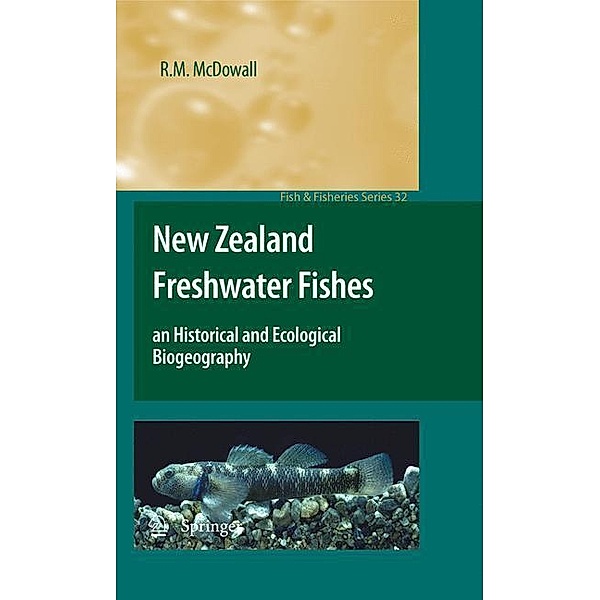New Zealand freshwater fishes
An historical and ecological biogeography
(Sprache: Englisch)
By providing a synthesis of taxonomic and ecological information on New Zealand's freshwater fish, this book connects the country's geological past to contemporary distribution patterns. It distinctly separates the roles of history and ecology in a fauna.
Leider schon ausverkauft
versandkostenfrei
Buch (Gebunden)
235.39 €
Produktdetails
Produktinformationen zu „New Zealand freshwater fishes “
By providing a synthesis of taxonomic and ecological information on New Zealand's freshwater fish, this book connects the country's geological past to contemporary distribution patterns. It distinctly separates the roles of history and ecology in a fauna.
Klappentext zu „New Zealand freshwater fishes “
In many ways, this book is the culmination of more than four decades of my exp- ration of the taxonomy, biogeography and ecology of New Zealand's quite small freshwater fish fauna. I began this firstly as a fisheries ecologist with the New Zealand Marine Department (then responsible for the nation's fisheries research and mana- ment), and then with my PhD at the Museum of Comparative Zoology at Harvard University, Cambridge, MA, USA in the early-mid 1960s. Since then, employed by a series of agencies that have successively been assigned a role in fisheries research in New Zealand, I have been able to explore very widely the natural history of that fauna. Studies of the fishes of other warm to cold temperate southern lands have followed, particularly southern Australia, New Caledonia, Patagonian South America, the Falkland Islands, and South Africa and, in many ways, have provided the rather broader context within which the New Zealand fauna is embedded in terms of geography, phylogeny, and evolutionary history, and knowing this context makes the patterns within New Zealand all the clearer. An additional stream in these studies, in substantial measure driven by the beh- ioural ecology of these fishes round the Southern Hemisphere, has been exploration of the role of diadromy (regular migrations between marine and freshwater biomes) in fisheries ecology and biogeography, and eventually of diadromous fishes wor- wide.
This book provides a synthesis of taxonomic and ecological information on New Zealand's freshwater fish fauna. New Zealand has been isolated in the southwestern Pacific Ocean since it separated from Gondwana during the Cretaceous period, some 80 million years ago. This prolonged geological isolation, combined with the islands' very vigorous geological history, impacted by oceanic submergence, tectonic activity, mountain building extreme volcanism, and great climatic variability, create a dynamic scenario within which the New Zealand biota, including its freshwater fishes, have evolved over millions of years. These impacts have contributed to a highly dynamic biological history with undoubted though little understood extinction and vigorous colonisation of the islands' fresh water. One of the key elements for understanding the origins and derivations of this fish fauna is that in all groups some or all of the species are diadromous, customarily spending a significant phase of their lives at sea. This has no doubt contributed in an important way the fauna's origins As well, there has been frequent loss of diadromous behaviours leading, to species that have abandoned their sea-migratory behaviours and which now complete their entire lives in fresh water. The distribution patterns reflect these changing habits, with diadromous species being broadly distributed but tending to be lowland in range, whereas the derived, non-diadromous species have narrower ranges, but are often found further inland and at high elevations. This book provides an ecological and historical synthesis of these divergent patterns across New Zealand's geography and history.
Inhaltsverzeichnis zu „New Zealand freshwater fishes “
New Zealand's Distinctive and Well-Known Freshwater Fish Fauna.- The Geographical Setting of New Zealand and Its Place in Global Geography.- New Zealand's Geological and Climatic History and Its Biogeographical Context.- A Conceptual Basis for Biogeography.- Some Essentials of Freshwater Fish Biogeography, Fish Life Histories, and the Place of Diadromy.- Data Sources for the Present Study.- Phylogenetic Lineages in the Fauna and the Evolution of Diadromy: A Broad Perspective.- Galaxias and Gondwana.- Broad-Scale, Macroecological Patterns, Ranges and Community Species Richness in the Fauna.- Pattern and Process in the Distributions and Biogeography of New Zealand Freshwater Fishes: The Diadromous Species.- Pattern and Process in the Distributions of Non-diadromous Species - 1: The Galaxias vulgaris Species Complex.- Pattern and Process in the Distributions of Non-diadromous Species 2: The 'Pencil-Galaxias' Species Group.- Pattern and Process in the Distributions of Non-diadromous Species 3: The Dune Lakes Galaxias.- Distribution, History and Biogeography of the Neochanna Mudfishes.- Distribution and Biogeography of the Non-diadromous Gobiomorphus Bullies.- A Biogeographical Synthesis: 1. The Big Picture.- Biogeographical Synthesis: 2. More Local Issues and Patterns.- A Biogeographical Synthesis 3: Issues of Diadromy, Diversification and Dispersal.- Some General Biogeographical Patterns in the Fish Fauna.- A More Global Perspective and a Final Summation.
Bibliographische Angaben
- Autor: R.M. McDowall
- 2010, 450 Seiten, Maße: 16 x 24,1 cm, Gebunden, Englisch
- Verlag: Springer Netherlands
- ISBN-10: 9048192706
- ISBN-13: 9789048192700
- Erscheinungsdatum: 06.08.2010
Sprache:
Englisch
Kommentar zu "New Zealand freshwater fishes"
0 Gebrauchte Artikel zu „New Zealand freshwater fishes“
| Zustand | Preis | Porto | Zahlung | Verkäufer | Rating |
|---|





Schreiben Sie einen Kommentar zu "New Zealand freshwater fishes".
Kommentar verfassen